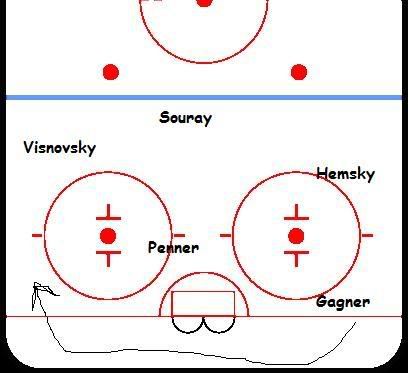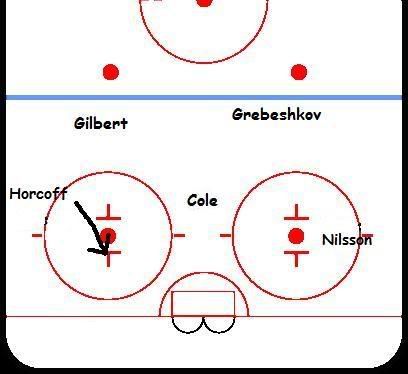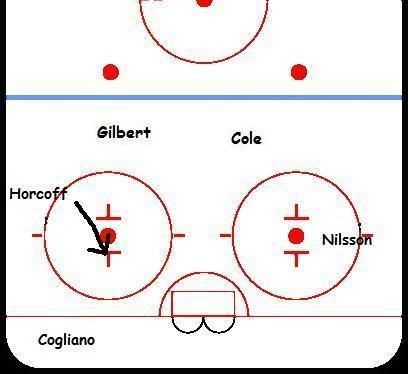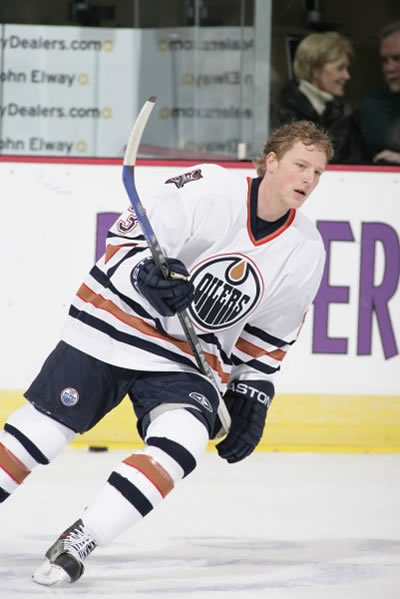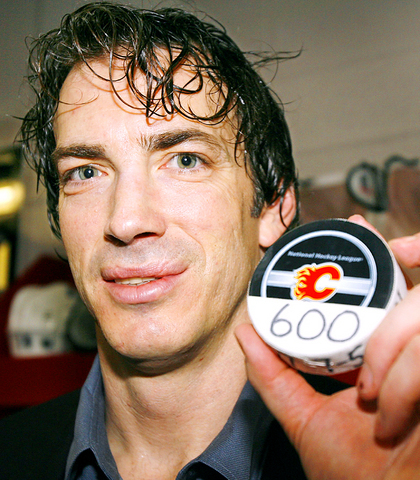
Jeff Petry is going to have play in at least one more classic MSU vs MU game before he gets to hit the NHL. I've prepared a top-20 list for the Oilers, much like Guy Flaming did a few days back. I'm also going to give a projected timeline for these guys, looking into the next 3-4 seasons and addressing how they would fit into the Oilers system over that time period. Remember, these are all pretty idealistic, as they are made
assuming that the prospects will stick around and achieve their full potential.eg) Chorney, Peckham, and Petry cannot all become top-4 defensemen with Visnovsky, Souray, and Gilbert all signed long-term.
1) Jeff PetryThat 2nd round pick in 2006 didn't turn out so bad afterall. After finishing his USHL career with a dominating performance, the 6'3 Petry picked up where he left off in the NCAA, standing out as a freshman in one of the toughest divisions in college hockey. He emerged as a 2-way dynamo for the Spartans, and was eventually picked to be on the Freshman All-Star team at the end of the year. He's easily the Oilers top defensive prospect, and should be a top-4 D-man in the mould of Braydon Cobourn, potentially even a top-2.
2008-2009: Will get #1 role with MSU, expected to dominate and finish as division All-Star
2009-2010: Becomes pro, starts year in AHL after impressive TC; #2 D-man after Chorney
2010-2011: #1 call-up option and potential bottom-6 player if Smid experiment ends, plays in AHL as top defenseman
2011-2012: Makes the team at age 24. Finishes year in top-4 with Gilbert-esque rookie year, ready to sign 2nd contract (Staios retirement opens up space for him to be top-4)
2) Riley NashThe lanky, freckly Nash made his college debut with Cornell this past year. Within two games, he was promoted to the top line, and finished the season tied for the team lead in points in one of the most defensive divisions in hockey.
He plays a great 2-way game, and should make the WJC tournament this year with Canada if he can keep up his impressive play. His potential is elite 3rd line center, with borderline 2nd line center offensive capabilities, similar to a Ryan Kesler/Travis Zajac. At 6'2, he's made for the job if he can put on the weight.
2008-2009: Dominates with Cornell, makes WJC team
2009-2010: Signs entry-level deal, sent to AHL, called up in case of bottom-6 center injury
2010-2011: Makes team out of TC, playing 4th line role, shows 3rd line potential later in season (especially if Brodziak dealt)
2011-2012: Established as 3rd line C
3) Rob Schremp
The saga continues with Rob Schremp, once the Oilers top offensive prospect, now struggling to make it into the NHL. Schremp had a great year with the Falcons, averaging almost a point/game. His offensive game is starting to show at the pro level, and his defensive play is improving. He's certainly got potential, but I'd say he's a late blooming version of Tim Connolly.
2008-2009: Schremp impresses at TC, yet can't find a spot on packed lineup. Is the #2 call-up option behind Brule, signs 1-year deal in off-season
2009-2010: Makes team out of TC on 4th line. In what may be his final year as an Oiler, he earns a new contract, unless the Oilers deal him due to depth issues (likely).
2010-2011: Plays on second line with Gagner/Nilsson (depending on if Brule pans out), or with Nash/Brodziak on 3rd line.
2011-2012: Established top-9 player in NHL
4) Theo PeckhamThe big, bruising defender made great strides in his first pro season. At a raw 19, he was able to dominate physically and defensively, and played like a 22-year old Matt Greene did in his first pro year. Peckham has an unbelievable amount of potential, as he's also got a pretty nice set of wheels for a man his size, and a decent wrist shot. If he can get his offensive game together, Peckham could end up like Shea Weber. But a more realistic projection for now is a Kevin Bieksa in Vancouver.
2008-2009: Challenges for bottom-7 spot, ousted due to depth, first call-up option, 1st pairing defender with Falcons
2009-2010: Makes team as bottom-pairing D-man.
2010-2011: Usurps Staios as shut-down option, cracks top-4
2011-2012: Established top-4 physical defenseman in NHL
5) Jordan EberleThe 2008 first-rounder tore up the WHL, scoring 42 goals to put him in the top-5 in league goal-scoring. He's got amazing scoring instincts, and scavenges around the net to finish a lot of plays. Eberle also possesses a strong wrist shot, solid play-making, and doesn't shy away from the physicality of big WHL defenders. Regardless, he's small, he's slow (for his size), and will need to work on bulking up and speed if he's going to pan out as a top-flight prospect. He's got Zach Parise-like potential if he does.
2008-2009: Rips up WHL
2009-2010: Signs entry-level deal, strongly challenges for a spot on opening day roster, #1 call-up all year long, especially if offensive player gets injured.
2010-2011: Makes the team a la Cogliano, gets legit chance with guys like Gagner and Nilsson.
2011-2012: Top-6 player, 20 goal scorer
6) Taylor ChorneyAlthough his last college year was disappointingly similar to his second, Chorney's development is not done yet. The mature blue-liner is ready to hit the pro ranks. He compensates for lack of size with great skating, intelligent decision-making, and smooth offensive abilities. He projects to potentially be a 2nd-pairing defenseman in the mould of Matt Niskanen
2008-2009: Makes top pairing in Springfield
2009-2010: 7th defenseman, gets some playing time in bottom 6 thanks to injury
2010-2011: Cracks team on bottom pairing, moves up to top-4
2011-2012: Hitting stride as 2-way defenseman on 2nd pairing
7) Jeff DeslauriersHardly a prospect anymore, Deslauriers is slated to make the big club this season. He hasn't played a single game in the NHL, and last year's AHL numbers may not look so good. But with a terrible defense in front of him, he was able to be the Falcons MVP, and showed his potential as a future NHL back-up. He's got size and some nice reflexes. He could eventually turn into a Mathieu Garon.
2008-2009: Back-up
2009-2010: Back-up
2010-2011: Solid back-up option
2010-2011: Shows starter potential
8) Ryan Potulny
Ryan Potulny followed up on an impressive NHL debut in 2006-2007 with a solid AHL campaign last season. He's no Schremp offensively, but his complete game and great shot make him an interesting prospect. I think he'll eventually make it as a bottom-6 player, but it won't be this year. I say he ends up like Glen Metropolit. A late bloomer that sticks in the bottom-6, but has the offensive skills to be a valuable asset at that position. If he can ever learn to play elite-level defense, you got a great 3rd line option.
2008-2009: Makes team as 13th forward, potential substitute for Stortini
2009-2010: 4th line player if he gets another contract
2010-2011: 4th line player
2011-2012: Defensive game begins to round out, becomes solid 2-way option in bottom-6 and potential 3rd liner.
9) Jean-Francois JacquesJacques continued his NHL cold streak, extending it to 53 games without a point. He had a terrible year, suffering a serious back injury in the AHL after putting up so-so numbers. He got another contract, because the team can't help but invest in a specimen like Jacques. He's got size, speed, and physicality, and has proven to be a great scorer in the minors. If he can ever get his shit together (as unlikely as it is), he could be a lethal power forward in the NHL, maxing out at a 2nd or 3rd line version of Erik Cole.
2008-2009: Looks good in TC, not enough for a spot, sent down.
2009-2010: Injury call-up, impresses enough to stick as 4th liner and Stortini substitute.
2010-2011: Manages to be a solid 4th liner all year long (if he gets a contract)
2011-2012: With Penner gone and Stortini's contract up, he has a legit chance to rise in the line up, even maxing out as a 2nd line option if his offense picks up.
10) Devyn DubnykThe tall, lanky goaltender put up average numbers in the AHL in his first full season there. With Deslauriers gone, he'll be expected to put up legit starter's numbers, and fulfill his 1st round draft pedigree. Dubnyk will have to use his size and rebound control to become an effective goaltender. I do believe he has starter's potential, and would compare him to Sean Burke or Mike Smith with his playing style.
2008-2009: Becomes outright starter in AHL, puts up solid numbers
2009-2010: Stands out as AHL all-star goalie, becomes Falcons MVP
2010-2011: Challenges Deslauriers in TC for back-up spot
2011-2012: Challenges for starter's position with Garon.
11) Josef HrabalMost people forgot the guy existed, but the 2003 draft pick signed an entry-level deal with the Oilers after a solid season in Russia, putting up Grebeshkov-esque numbers with Cherepovets. I'd say his potential is a slightly lesser version of Grebeshkov, and I really doubt he'll pan out (might just go to the KHL), but if he does:
2008-2009: Solid top-4 option in AHL
2009-2010: Challenges Chorney for 6-7 spot
2010-2011: If he re-signs, he'll be in the top-6
2011-2012: Established bottom-pairing defenseman a la Andrei Zyuzin
12) Alex PlanteAlthough he's got excellent draft pedigree, Plante's atrocious 2007-2008 season makes him a far-away prospect for now. Injuries in both prospect camp and mid-season in the WHL cost him his top-pairing role, and he ended the year with limited ice time in the Hitmen's playoff run. If he's going to bounce back, he's going to have to stay healthy, improve his speed, and get his overall development back on track. He's got Sheldon-Souray like potential, especially if he can get his shot in gear.
2008-2009: Strong bounce-back year with Hitmen
2009-2010: Signs entry-level deal, plays year with Falcons
2010-2011: Impresses at TC with 2-way ability, plays with Falcons
2011-2012: Cracks roster in bottom-6
13) Ryan O'Marra
The kid has fallen off the charts since an amazing 2007 WHC, where he looked like the next Rob Neidermeyer. O'Marra stopped talking, and started to play hockey towards the end of last season. He managed to stick with the Falcons for the final stretch, and looked impressive with his 2-way game. Regardless, he was only a bottom-6 player at that stage. He's got amazing face-off abilities and should get a real long look in a couple of years. Overall, I think his potential for now is a lesser version of Ryan Kesler, maybe even just a 4th line player. He's definitely going to be an NHL player, regardless of what role he plays.
2008-2009: Becomes top-6 player in AHL, challenges for top line
2009-2010: Competes with Nash in TC, becomes top-line forward with Falcons, call-up option
2010-2011: Cracks roster as 4th line center, moves up when injuries strike.
2011-2012: Centers Nash on third line.
14) Chris Vande VeldeIt's hard to tell if Vande Velde's past season was more attributable to his linemates or his own development. This is why he's not ranked higher, for the offensive potential he showed with North Dakota would put him in the top-10 for sure. Playing with top prospect T.J Oshie and offensive dynamo Ryan Duncan doesn't hurt either, nor does having a top defenseman like Taylor Chorney to move the puck. But Vande Velde impressed at Oilers' prospect camp this past summer with his physical development and offensive capabilities. If he pans out, we could have a David Backes on our hands.
2008-2009: Plays top-line with UND, puts up numbers similar to last year
2009-2010: Plays senior year as 22-year old, improves offensive stats
2010-2011: Signs entry-level deal, plays AHL and finishes year in top-6.
2011-2012: Challenges Jacques (if he's still around) for the power forward spot with Penner's contract done.
15) Liam Reddox
After a quiet 2006-2007 campaign split between the ECHL and the AHL, Reddox exploded in 2007-2008 with a Brodziak-esque like year. He put up 44 points in a second-line role, showing a strong 2-way game that got him in an NHL game with the big club this season. If he can take it to another gear in terms of offensive productivity in the AHL, we might have another Kyle Brodziak on our hands, with the relentlessness of a Kris Draper.
2008-2009: Impresses at TC, buried by depth and plays 2nd line C in AHL
2009-2010: Makes it as 13th forward, sees some NHL action
2010-2011: Potential Pouliot/Brodziak replacement on 3rd/4th line.
2011-2012: Established bottom-6 player.
16) Cody Wild
Wild is a pure offensive defenseman who graduated to the AHL late last year after a succesful tenure with Providence. There, he learned somewhat when to jump into the play and when to take care of the zone, but still his poor decision-making and overall defensive game remains his only obstacle to pro success. He has great PP presence, and great skating, and would be an amazing offensive talent in the NHL. If he can ever round out his 2-way game, he could be a John-Michael Liles.
2008-2009: Solid top-6 player with Falcons, 2nd unit PP QB
2009-2010: Top-4 defenseman with Falcons, #1 PP option
2010-2011: 2-way game progresses to stage where he's top-pairing in AHL, #1 call-up
2011-2012: Essentially one-dimensional bottom-pairing defender in NHL, used primarily for PP and offensive capabilities.
17) Slava TrukhnoComing in with high expectations after an explosive final year in the QMJHL, Trukhno struggled to find his offensive game most of last season with the Falcons. The last month, however, he really took off, scoring at a point/game clip. He has great offensive instincts, and does play on both ends of the ice unlike most Europeans. He's got potential to be somewhat of a Nilsson, but he'll have to find his game in the AHL before it happens.
2008-2009: Established 2nd liner with Falcons, pushes for 1st line
2009-2010: Impressive TC almost gets him a spot, #1 line with Falcons
2010-2011: Gets a shot with skilled players on 4th line with Oilers
2011-2012: Development earns some time on 2nd line, impresses with 2-way abilities; versatile player that can play all lines
18) Linus Omark
On the basis of skill and offensive instincts alone, Omark may be the Oilers top prospect. He was able to put up Fabian Brunnstrom-like numbers in the SEL, yet is a year younger than the much-hyped Stars prospect. The only limitation to Omark is his size. At 5'9, he needs to beef up if he's going to make it in the NHL. So far, he shows relentless work ethic and never backs down from physicality in Sweden. He's got great scoring touch and playmaking instincts. I think he's in the Sami Kapanen-mould in terms of overall NHL potential if his size doesn't become a factor.
2008-2009: Impresses in SEL, becomes top-line player with Lulea, gains weight
2009-2010: Signs 2-way deal with Oilers, makes statement with flashy offensive skill at TC, top line AHL player, call-up if top-6 player goes down
2009-2010: Cracks 3rd line, but offensive game has him eventually promoted to 2nd line.
2010-2011: 2nd line NHL player.
19) Johan MotinA Peckham-like physical specimen at the age of 18, Motin exists so low on the list just because of the uncertainty of his future with the Oilers organization. He is the prototypical old-time shutdown defenseman. He makes the simple, safe play, uses his body a lot to separate his man from the puck, and never backs down from physical play. If he ever does make it to N. America, he may be a less explosive version of Vitaly Vishnevski, with a more effective overall defensive game.
2008-2009:
Becomes top-4 defenseman in SEL
2009-2010: Top shut-down defenseman on SEL team
2010-2011: Shows NHL-ready game in SEL and international tournaments
2011-2012: Signs 2-way deal with Oilers, challenges over next couple years for bottom-6 spot.
20) Sebastian Bisaillion
After a ridiculous start to his 2008-2009 campaign, Bisaillion suffered a scary leg injury that pushed him out for the season. He was starting to look like a legitimate call-up option for that season, too. He has great offensive game for a bottom-pairing defenseman, and manages to hold his own in the defensive zone, using physicality and average decision-making. He's got the same kind of potential as a guy like Rory Fitzpatrick: decent 2-way ability but not quite NHL-calibre enough to be a legitimate starter. Reserve potential.
2008-2009: Remain top-6 with Falcons, pressure Roy for top-4 spot.
2009-2010: Become legit top-4 defenseman with Falcons and put up points.
2010-2011: Challenge for 7th spot, #1 call-up option for 7th spot
2011-2012: 6/7 defenseman in NHL.
Honorable Mentions:
Alexei Mikhnov: Top-15 in terms of actual skill and potential, but the likelihood of him staying in the KHL is too great to make him a legit top-20 prospect.
Stephane Goulet: After showing much goal-scoring prowess in junior, Goulet's game has failed to translate into AHL success, and is likely never going to make the NHL.
Colin MacDonald: After making excuses for his lack of scoring with Providence, the Oilers can no longer hide Macdonald's failure as a 2nd-round pick. He did put up points with the Falcons, but hasn't showed the kind of poise that would make him an NHLer.
Bryan Pitton: After a solid last year in the OHL, Pitton has a shot at becoming a back-up in the NHL. He's got quite a ways to go, though, as he's got to surpass Dubnyk on the depth chart before he becomes an option.
Milan Kytnar: He came with much mystery to the CHL last year, but failed to accomplish much offensively. Doesn't seem to have a 2-way game strong enough to become a legit bottom-6 presence in the NHL.
 It's never easy to simply just throw out expected point totals for players in any league. There are simply too many factors to consider. Injuries, trades, and line changes can cause serious changes in a player's output, but I'm going to make these predictions based on the line-ups I projected in the last post, and in anticipation of a healthy year from the opening day roster. Like I said, I'm no Falcons expert, so I'd appreciate any feedback from readers on these numbers, just for personal reference..
It's never easy to simply just throw out expected point totals for players in any league. There are simply too many factors to consider. Injuries, trades, and line changes can cause serious changes in a player's output, but I'm going to make these predictions based on the line-ups I projected in the last post, and in anticipation of a healthy year from the opening day roster. Like I said, I'm no Falcons expert, so I'd appreciate any feedback from readers on these numbers, just for personal reference..
